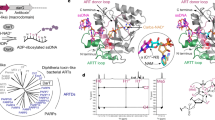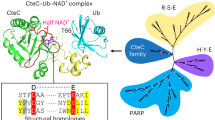Abstract
ADP-ribosylation factors (ARFs) are essential and ubiquitous in eukaryotes, being involved in vesicular transport and functioning as an activator of phospholipase D (refs 1,2) and cholera toxin3,4. The functions of ARF proteins in membrane traffic and organelle integrity5,6 are intimately tied to its reversible association with membranes and specific interactions with membrane phospholipids. One common feature of these functions is their regulation by the binding and hydrolysis of GTP. Here we report the three-dimensional structure of full-length human ARF1 (Mr 21,000) in its GDP-bound non-myristoylated form. The presence of a unique amino-terminal α-helix and loop, together with differences in Mg2+ ligation and the existence of a non-crystallographic dimer, set this structure apart from other GTP-binding proteins. These features provide a structural basis for the GTP-dependent modulation of membrane affinity, the lack of intrinsic GTPase activity, and the nature of effector binding surfaces.
This is a preview of subscription content, access via your institution
Access options
Subscribe to this journal
Receive 51 print issues and online access
$199.00 per year
only $3.90 per issue
Buy this article
- Purchase on Springer Link
- Instant access to full article PDF
Prices may be subject to local taxes which are calculated during checkout
Similar content being viewed by others
References
Brown, H. A. et al. Cell 75, 1137–1144 (1993).
Cockcroft, S. et al. Science 263, 523–526 (1994).
Kahn, R. A., Yucel, J. K. & Malhotra, V. Cell 75, 1045–1048 (1993).
Rosenwald, A. G. & Kahn, R. A. in GTPase-controlled Molecular Machines (eds Corda, D., Hamm, H. & Luini, A., Ares-Serono publications, Rome, Italy, 1994).
Zhang, C.-J. et al. J. Cell Biol. 124, 289–300 (1994).
Kahn, R. A. et al. J. biol. Chem. (in the press).
Tong, L., DeVos, A. M., Milburn, M. V. & Kim, S.-H. J. molec. Biol. 217, 503–516 (1991).
Seuell, J. L. & Kahn, R. A. Proc. natn. Acad. Sci. U.S.A. 85, 4620–4624 (1988).
Lambert, D. G., Noel, J. P., Hamm, H. E. & Sigler, P. B. Nature 369, 621–628 (1994).
Kjeldgaard, M. & Nyborg, J. J. molec. Biol. 223, 721–742 (1992).
Barbacid, M. A. Rev. Biochem. 56, 779–827 (1987).
Kahn, R. A. et al. J. biol. Chem. 267, 13039–13046 (1992).
Kahn, R. A., Goddard, C. & Newkirk, M. J. biol. Chem. 263, 8282–8287 (1988).
Kahn, R. A. & Gilman, A. G. J. biol. Chem. 261, 7906–7911 (1986).
Kahn, R. A., Kern, F. G., Clark, J., Gelmann, E. P. & Rulka, C. J. biol. Chem. 266, 2606–2614 (1991).
Bullough, P. A., Hughson, F. M., Skehel, J. J. & Wiley, D. C. Nature 371, 37–43 (1991).
Frech, M. et al. Biochemistry 33, 3237–3244 (1994).
Weiss, O., Holden, J., Rulka, C. & Kahn, R. A. J. biol. Chem. 264, 21066–21072 (1989).
Marshall, M. S. Trends Biochem. Sci. 18, 250–254 (1993).
Dickerson, R. E., Weizerl, J. E. & Palmer, R. A. Acta crystallogr. B24, 997–1003 (1968).
Wang, B. C. Meth. Enzym. 115, 90–112 (1985).
Zhang, K. Y. J. Acta crystallogr. D49, 213–222 (1993).
Jones, T. A. Acta crystallogr. A47, 110–119 (1991).
Kabsch, W., Mannherz, H. G., Suck, D., Pai, E. F. & Holmes, K. C. Nature 347, 37–44 (1990).
Brunger, A. T. X-PLOR Version 3.1 Manual (Yale University, New Haven, 1993).
Fontano, E. & Peisach, D. peisach@auriga.rose.brandeis.edu, RAYSCRIPT.
Kraulis, P. J. J. appl. Crystallogr. 24, 946–950 (1991).
RAYSHADE, obtained from Coffin, L. & DeBry, D.; (Icoffin@clciris.chem.umr.edu and ddebry@ dsd.es.com).
QUANTA 4.0 Molecular Simulations Inc., Burlington, Massachusetts, USA.
CSC ChemDraw 3.1, Cambridge Scientific Computing, Inc., Cambridge, Massachusetts, USA.
Genetics Computer Group, Program Manual for the GCG Package, Version 7, Madison, Wisconsin, USA.
John, J., Schlichting, I., Schiltz, E., Rosch, P. & Wittinghofer, A. J. biol. Chem. 264, 13086–13092 (1989).
Halkides, C. J., Farrar, C. T., Larsen, R. G., Redfield, A. G. & Singel, D. J. Biochemistry 33, 4019–4035 (1994).
Author information
Authors and Affiliations
Rights and permissions
About this article
Cite this article
Carlos Amor, J., Harrison, D., Kahn, R. et al. Structure of the human ADP-ribosylation factor 1 complexed with GDP. Nature 372, 704–708 (1994). https://doi.org/10.1038/372704a0
Received:
Accepted:
Issue Date:
DOI: https://doi.org/10.1038/372704a0
This article is cited by
-
Dominant ARF3 variants disrupt Golgi integrity and cause a neurodevelopmental disorder recapitulated in zebrafish
Nature Communications (2022)
-
Cloning and characterization of ADP-ribosylation factor 1b from the olive flounder Paralichthys olivaceus
Fisheries and Aquatic Sciences (2017)
-
Structure, organization and evolution of ADP-ribosylation factors in rice and foxtail millet and their expression in rice
Scientific Reports (2016)
-
Two flagellar BAR domain proteins in Trypanosoma brucei with stage-specific regulation
Scientific Reports (2016)
-
Ectopic expression a maize ADP-ribosylation factor gene in Arabidopsis, increase plant size and growth rate
Journal of Plant Biochemistry and Biotechnology (2015)
Comments
By submitting a comment you agree to abide by our Terms and Community Guidelines. If you find something abusive or that does not comply with our terms or guidelines please flag it as inappropriate.



